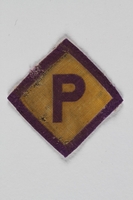Overview
- Brief Narrative
- Forced labor badge, blue with OST in white letters, found by Jim Newton, a US soldier, in April 1945 in Germany. The badge would have been worn by a forced laborer to identify them as an Ostarbeiter [Worker from the East], usually Russian or Ukrainian, deported to work in Nazi Germany. The patch would have been sewn to the chest with the outer white border visible. After Germany attacked the Soviet Union in the spring of 1941, the need for forced labor to support the war effort became an urgent necessity. Beginning in 1942, millions of forced laborers were deported from the Soviet Union to work in factories and other civilian labor details. They were housed in so-called residence camps that often had barbed wire and SS guards. They were treated as second class citizens and kept separate from the general population. After the war ended in 1945, nearly 6 million eastern workers were repatriated to the Soviet Union where they often were discriminated against and accused of being traitors to their country.
- Date
-
found:
1945 April
- Geography
-
found:
Germany
- Credit Line
- United States Holocaust Memorial Museum Collection, Gift of James D. Newton
- Markings
- front center, white cloth letters within a dyed dark blue field : OST [Ostarbeiter: Eastern worker]
Physical Details
- Language
- German
- Classification
-
Identifying Artifacts
- Category
-
Badges
- Object Type
-
Forced labor badges (ushmm)
- Physical Description
- Square white cotton cloth with a badge design printed on one side with dark blue dye. In the center is a white 3 letter acronym, OST, upon a dark blue square field. That square is bordered by an outline of undyed white cloth which is then bordered by a dyed dark blue outline. There are dark stains on the front and frayed edges.
- Dimensions
- overall: Height: 1.500 inches (3.81 cm) | Width: 1.500 inches (3.81 cm)
- Materials
- overall : cotton, dye
Rights & Restrictions
- Conditions on Access
- No restrictions on access
- Conditions on Use
- No restrictions on use
Keywords & Subjects
Administrative Notes
- Legal Status
- Permanent Collection
- Provenance
- The forced labor badge was donated to the United States Holocaust Memorial Museum in 1995 by Jim Newton.
- Record last modified:
- 2023-08-18 14:08:23
- This page:
- https://collections.ushmm.org/search/catalog/irn8924
Download & Licensing
In-Person Research
- By Appointment
- Request 21 Days in Advance of Visit
- Plan a Research Visit
- Request to See This Object
Contact Us
Also in James D. Newton collection
The collection consists of two identification badges found postwar at Dachau concentration camp.
Date: 1945

Forced labor badge, yellow with a purple P, to identify a Polish forced laborer acquired by a US soldier
Object
Forced labor badge, yellow with a purple P and a purple border, found by Jim Newton, a US soldier, in April 1945 in Germany. This badge would be worn to identify a Polish forced laborer in Nazi Germany. German regulations required the workers to wear the badge with the purple band visible around the P on the right chest to keep them separate from the German populace. During the German occupation of Poland, 1939-1945, many non-Jewish Polish people were sent to Germany as conscript labor for civilian labor details on farms and factories. Workers sometimes volunteered for the forced labor service, but the majority were forcibly recruited and conditions worsened as the war continued. The German work force was depleted by the war and unpaid foreign workers were needed to keep the economy functioning.



